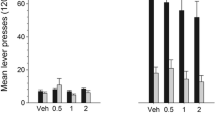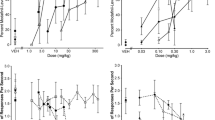Abstract
Rationale
Both dopamine (DA) and serotonin (5-HT) release are evoked by (+)-MDMA; however, little is known of the contribution of DA D1- and D2-like receptors (D1R and D2R, respectively) in the behavioral effects of (+)-MDMA.
Objectives
To test the hypothesis that a D1R or D2R antagonist would attenuate the hypermotive or discriminative stimulus effects of (+)-MDMA.
Methods
Male Sprague-Dawley rats (n=164) were pretreated with the D1R antagonist SCH 23390 (3.125–50 μg/kg, SC) or the D2R antagonist eticlopride (12.5–50 μg/kg, SC) prior to treatment with (+)-MDMA (3 mg/kg, SC) and locomotor activity was recorded using photobeam monitors. Twelve additional rats trained to discriminate (+)-MDMA (1 mg/kg, IP) from saline in a two-lever water-reinforced FR20 task were administered SCH 23390 (6.25 μg/kg, IP) or eticlopride (12.5 μg/kg, IP) prior to (+)-MDMA (0.375–1.0 mg/kg, IP). Rats were then placed in the drug discrimination chambers and the percent (+)-MDMA appropriate responding and response rate were measured.
Results
Both SCH 23390 and eticlopride blocked (+)-MDMA-evoked hyperactivity in a dose-related manner; the highest doses of the antagonists also effectively suppressed basal locomotor activity. In rats trained to discriminate (+)-MDMA from saline, SCH 23390 (6.25 μg/kg), but not eticlopride (12.5 μg/kg), blocked the stimulus effects of (+)-MDMA without altering response rate.
Conclusion
These data indicate that DA released indirectly by (+)-MDMA administration results in stimulation of D1R and D2R to enhance locomotor activity. Furthermore, the D1R appears to play a more prominent role than the D2R in the discriminative stimulus properties of (+)-MDMA.





Similar content being viewed by others
References
Agmo A, Soria P (1999) The duration of the effects of a single administration of dopamine antagonists on ambulatory activity and motor coordination. J Neural Transm 106:219–227
Arnt J (1985) Behavioral stimulation is induced by separate dopamine D-1 and D-2 receptor sites in reserpine-pretreated but not in normal rats. Eur J Pharmacol 113:79–88
Baker LE, Virden TB, Miller ME, Sullivan CL (1997) Time course analysis of the discriminative stimulus effects of the optical isomers of 3,4-methylenedioxymethamphetamine (MDMA). Pharmacol Biochem Behav 58:505–516
Bankson MG, Cunningham KA (2001) 3,4-Methylenedioxymethamphetamine (MDMA) as a unique model of serotonin receptor function and serotonin-dopamine interactions. J Pharmacol Exp Ther 297:846–852
Bankson MG, Cunningham KA (2002) Pharmacological studies of the acute effects of (+)-3,4-methylenedioxymethamphetamine on locomotor activity: role of 5-HT(1B/1D) and 5-HT(2) receptors. Neuropsychopharmacology 26:40–52
Benloucif S, Keegan MJ, Galloway MP (1993) Serotonin-facilitated dopamine release in vivo: pharmacological characterization. J Pharmacol Exp Ther 265:373–377
Bouthenet ML, Souil E, Martres MP, Sokoloff P, Giros B, Schwartz JC (1991) Localization of dopamine D3 receptor mRNA in the rat brain using in situ hybridization histochemistry: comparison with dopamine D2 receptor mRNA. Brain Res 564:203–219
Callahan PM, Cunningham KA (1993) Discriminative stimulus properties of cocaine in relation to dopamine D2 receptor function in rats. J Pharmacol Exp Ther 266:585–592
Callahan PM, Appel JB, Cunningham KA (1991) Dopamine D1 and D2 mediation of the discriminative stimulus properties of d-amphetamine and cocaine. Psychopharmacology 103:50–55
Callahan PM, De La Garza R, Cunningham KA (1994) Discriminative stimulus properties of cocaine: modulation by dopamine D1 receptors in the nucleus accumbens. Psychopharmacology 115:110–114
Callahan PM, De La Garza R, Cunningham KA (1997) Mediation of the discriminative stimulus properties of cocaine by mesocorticolimbic dopamine systems. Pharmacol Biochem Behav 57:601–607
Callaway CW, Geyer MA (1992) Stimulant effects of 3,4-methylenedioxymethamphetamine in the nucleus accumbens of rat. Eur J Pharmacol 214:45–51
Callaway CW, Wing LL, Geyer MA (1990) Serotonin release contributes to the locomotor stimulant effects of 3,4-methylenedioxymethamphetamine in rats. J Pharmacol Exp Ther 254:456–464
Canales JJ, Iversen SD (2000) Dynamic dopamine receptor interactions in the core and shell of nucleus accumbens differentially coordinate the expression of unconditioned motor behaviors. Synapse 36:297–306
Chausmer AL, Katz JL (2001) The role of D2-like dopamine receptors in the locomotor stimulant effects of cocaine in mice. Psychopharmacology 155:69–77
Cole JC, Sumnall HR (2003) The pre-clinical behavioural pharmacology of 3,4-methylenedioxymethamphetamine (MDMA). Neurosci Biobehav Rev 27:199–217
Dearry A, Gingrich JA, Falardeau P, Fremeau RT Jr, Bates MD, Caron MG (1990) Molecular cloning and expression of the gene for a human D1 dopamine receptor. Nature 347:72–76
Erinoff L, Brown RM (eds) (1994) Neurobiological models for evaluating mechanisms underlying cocaine addiction. National Institute on Drug Abuse Research Monograph no. 145, US Government Printing Office, Washington, D.C.
Extance K, Goudie AJ (1981) Inter-animal olfactory cues in operant drug discrimination procedures in rats. Psychopharmacology 73:363–371
Frankel PS, Cunningham KA (2003) Modulation of the discriminative properties of (+)-MDMA by agonists acting at 5-HT2C and 5-HT1B receptors (5-HT2CR & 5-HT1BR). Late-breaking research, 65th Annual College on Problems of Drug Dependence Meeting
Glennon RA, Yousif M, Patrick G (1988) Stimulus properties of 1-(3,4-methylenedioxyphenyl)-2-aminopropane (MDA) analogs. Pharmacol Biochem Behav 29:443–449
Gold LH, Koob GF, Geyer MA (1988) Stimulant and hallucinogenic behavioral profiles of 3,4-methylenedioxymethamphetamine and N-ethyl-3,4-methylenedioxyamphetamine in rats. J Pharmacol Exp Ther 247:547–555
Gold LH, Hubner CB, Koob GF (1989) A role for the mesolimbic dopamine system in the psychostimulant actions of MDMA. Psychopharmacology 99:40–47
Goodwin AK, Pynnonen DM, Baker LE (2003) Serotonergic-dopaminergic mediation of MDMA’s discriminative stimulus effects in a three-choice discrimination. Pharmacol Biochem Behav 74:987–995
Gudelsky GA, Nash JF (1996) Carrier-mediated release of serotonin by 3,4-methylenedioxymethamphetamine: implications for serotonin-dopamine interactions. J Neurochem 66:243–249
Hall H, Sallemark M, Jerning E (1986) Effects of remoxipride and some related new substituted salicylamides on rat brain receptors. Acta Pharmacol Toxicol (Copenh) 58:61–70
Jackson DM, Hashizume M (1986) Bromocriptine induces marked locomotor stimulation in dopamine-depleted mice when D-1 dopamine receptors are stimulated with SKF38393. Psychopharmacology 90:147–149
Jackson DM, Westlind-Danielsson A (1994) Dopamine receptors: molecular biology, biochemistry and behavioural aspects. Pharmacol Ther 64:291–370
Johnston LD, O’Malley PM, Bachman JG (2003) Monitoring the Future national results on adolescent drug use: overview of key findings, 2002. NIH Publication No. 03-5374, National Institute on Drug Abuse, Bethesda, Md.
Kehne JH, Ketteler HJ, McCloskey TC, Sullivan CK, Dudley MW, Schmidt CJ (1996) Effects of the selective 5-HT2A receptor antagonist MDL 100,907 on MDMA-induced locomotor stimulation in rats. Neuropsychopharmacology 15:116–124
Keppel G (1973) Design and analysis: a researcher’s handbook. Prentice-Hall, Englewood Cliffs, N.J.
Koch S, Galloway MP (1997) MDMA induced dopamine release in vivo: role of endogenous serotonin. J Neural Transm 104:135–146
Lachowicz JE, Sibley DR (1997) Molecular characteristics of mammalian dopamine receptors. Pharmacol Toxicol 81:105–113
Landwehrmeyer B, Mengod G, Palacios JM (1993) Differential visualization of dopamine D2 and D3 receptor sites in rat brain. A comparative study using in situ hybridization histochemistry and ligand binding autoradiography. Eur J Neurosci 5:145–153
Lawler CP, Prioleau C, Lewis MM, Mak C, Jiang D, Schetz JA, Gonzalez AM, Sibley DR, Mailman RB (1999) Interactions of the novel antipsychotic aripiprazole (OPC-14597) with dopamine and serotonin receptor subtypes. Neuropsychopharmacology 20:612–627
Levant B, Grigoriadis DE, DeSouza EB (1992) Characterization of [3H]quinpirole binding to D2-like dopamine receptors in rat brain. J Pharmacol Exp Ther 262:929–935
Lucas G, Spampinato U (2000) Role of striatal serotonin2A and serotonin2C receptor subtypes in the control of in vivo dopamine outflow in the rat striatum. J Neurochem 74:693–701
McCreary AC, Bankson MG, Cunningham KA (1999) Pharmacological studies of the acute and chronic effects of (+)-3,4-methylenedioxymethamphetamine on locomotor activity: role of 5-hydroxytryptamine(1A) and 5-hydroxytryptamine(1B/1D) receptors. J Pharmacol Exp Ther 290:965–973
Meador-Woodruff JH, Mansour A, Grandy DK, Damask SP, Civelli O, Watson SJ Jr (1992) Distribution of D5 dopamine receptor mRNA in rat brain. Neurosci Lett 145:209–212
National Research Council (1996) Guide for the care and use of laboratory animals. National Academy Press, Washington D.C.
Ng NK, Lee HS, Wong PT (1999) Regulation of striatal dopamine release through 5-HT1 and 5-HT2 receptors. J Neurosci Res 55:600–607
Nielsen EB, Randrup K, Andersen PH (1989) Amphetamine discrimination: effects of dopamine receptor agonists. Eur J Pharmacol 160:253–262
O’Malley KL, Harmon S, Tang L, Todd RD (1992) The rat dopamine D4 receptor: sequence, gene structure, and demonstration of expression in the cardiovascular system. New Biol 4:137–146
O’Neill MF, Shaw G (1999) Comparison of dopamine receptor antagonists on hyperlocomotion induced by cocaine, amphetamine, MK-801 and the dopamine D1 agonist C-APB in mice. Psychopharmacology 145:237–250
Oberlender R, Nichols DE (1988) Drug discrimination studies with MDMA and amphetamine. Psychopharmacology 95:71–76
Parsons LH, Koob GF, Weiss F (1999) RU 24969, a 5-HT1B/1A receptor agonist, potentiates cocaine-induced increases in nucleus accumbens dopamine. Synapse 32:132–135
Porras G, Di M, V, Fracasso C, Lucas G, De Deurwaerdere P, Caccia S, Esposito E, Spampinato U (2002) 5-HT2A and 5-HT2C/2B receptor subtypes modulate dopamine release induced in vivo by amphetamine and morphine in both the rat nucleus accumbens and striatum. Neuropsychopharmacology 26:311–324
Rothman RB, Baumann MH, Dersch CM, Romero DV, Rice KC, Carroll FI, Partilla JS (2001) Amphetamine-type central nervous system stimulants release norepinephrine more potently than they release dopamine and serotonin. Synapse 39:32–41
Rudnick G, Wall SC (1992) The molecular mechanism of “ecstasy” [3,4-methylenedioxy-methamphetamine (MDMA)]: serotonin transporters are targets for MDMA-induced serotonin release. Proc Natl Acad Sci USA 89:1817–1821
Schechter MD (1989) Serotonergic-dopaminergic mediation of 3,4-methylenedioxymethamphetamine (MDMA, “ecstasy”). Pharmacol Biochem Behav 31:817–824
Schechter MD (1997) Drug-drug discrimination: stimulus properties of drugs of abuse upon a serotonergic-dopaminergic continuum. Pharmacol Biochem Behav 56:89–96
Smith FL, St John C, Yang TF, Lyness WH (1989) Role of specific dopamine receptor subtypes in amphetamine discrimination. Psychopharmacology 97:501–506
Spanos LJ, Yamamoto BK (1989) Acute and subchronic effects of methylenedioxymethamphetamine [(±)MDMA] on locomotion and serotonin syndrome behavior in the rat. Pharmacol Biochem Behav 32:835–840
Starr BS, Starr MS (1987) Behavioural interactions involving D1 and D2 dopamine receptors in non-habituated mice. Neuropharmacology 26:613–619
Waddington JL, O’Boyle KM (1989) Drugs acting on brain dopamine receptors: a conceptual re-evaluation five years after the first selective D-1 antagonist. Pharmacol Ther 43:1–52
White SR, Duffy P, Kalivas PW (1994) Methylenedioxymethamphetamine depresses glutamate-evoked neuronal firing and increases extracellular levels of dopamine and serotonin in the nucleus accumbens in vivo. Neuroscience 62:41–50
Wise RA, Bozarth MA (1987) A psychomotor stimulant theory of addiction. Psychol Rev 94:469–492
Yamamoto BK, Spanos LJ (1988) The acute effects of methylenedioxymethamphetamine on dopamine release in the awake-behaving rat. Eur J Pharmacol 148:195–203
Acknowledgements
This research was supported by the National Institute on Drug Abuse DA 00260, DA 06057, DA 13595, and DA 15259. We would like to thank Robert G. Fox for his technical assistance. Also, we thank Jeffrey Burmeister, David Herin, and Erik Shank for their valuable comments and suggestions upon reviewing the manuscript. Portions of this work were presented at the annual meeting of The College on Problems of Drug Dependence held in Bal Harbour, Fla., in June, 2003.
Author information
Authors and Affiliations
Corresponding author
Rights and permissions
About this article
Cite this article
Bubar, M.J., Pack, K.M., Frankel, P.S. et al. Effects of dopamine D1- or D2-like receptor antagonists on the hypermotive and discriminative stimulus effects of (+)-MDMA. Psychopharmacology 173, 326–336 (2004). https://doi.org/10.1007/s00213-004-1790-1
Received:
Accepted:
Published:
Issue Date:
DOI: https://doi.org/10.1007/s00213-004-1790-1




